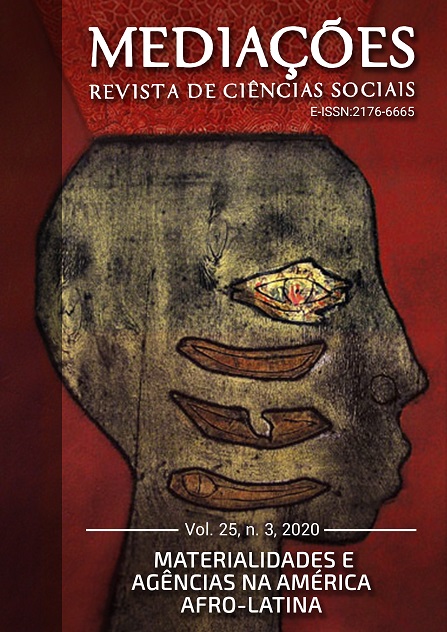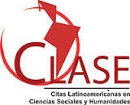En las huellas de Hyppolite: pintura popular haitiana entre religión y arte
DOI:
https://doi.org/10.5433/2176-6665.2020v25n3p602Palabras clave:
Haiti, Vudú, Pintura popular, arte, religiónResumen
Este artículo, basado en una etnografía con documentos históricos, busca reflexionar sobre las prácticas de construcción del llamado "arte popular" en Haití a mediados del siglo XX. Para ello, sigue la creación y los primeros años de funcionamiento del Center d'Art, un centro de producción y difusión de las artes plásticas haitianas creado en 1944, y la circulación de sus primeras exposiciones en el extranjero. Se hace especial hincapié en la narrativa articulada por la institución en torno al célebre pintor y sacerdote vudú Héctor Hyppolite (1894-1948), quien, según él, es considerado como una especie de artefacto circulante. La obra y la figura misma de Hyppolite funcionan así como la imagen condensada de un "Haití popular" que se quería proyectar en ese momento, marcado por sus raíces africanas expresadas tanto en el ámbito religioso como artístico.Descargas
Citas
BRETON, André. Hector Hyppolite. In: BRETON, A. Le surréalisme et la peinture. Paris: Gallimard, 1965. p. 394-399.
BRUMANA, Fernando. El Métraux haitiano: la construcción de una etnología religiosa. Journal de la Société des Américanistes, Paris, v.102, n. 2, p. 145-167, 2016.
CASTAÑEDA, Luís M. Island Culture Wars: Selden Rodman and Haiti. Art Journal, New York, v. 73, n. 3, p. 56-69, 2014.
CÉLIUS, Carlo Avierl. Langage plastique et énonciation identitaire. L'invention de l'art haïtien. Québec: Les presses de L'Université Laval, 2007.
CÉLIUS, Carlo Avierl. Quelques aspects de la nouvelle scène artistique d'Haïti. Gradhiva, Paris, n. 21, p. 104-129, 2015.
CHENET, Jean; THOBY-MARCELIN, Phillipe. La double vie d'Hector Hyppolite (extraits). Conjonction, Port-au-Prince, n. 16, 1948.
DUBOIS, Laurent. Haiti: the aftershocks of history. New York: Metropolitan Books, 2012.
DURANTON-CRABOL, Anne-Marie. Les intellectuels français en exil aux Etats-Unis pendant la Seconde Guerre mondiale: aller et retour. Matériaux Pour L'histoire de Notre Temps, Paris, n. 60, p. 41-47, 2000.
GEIS, Terri. Myth, History and repetition: André Breton and Vodou in Haiti. South Central Review, Baltimore, v. 32, n. 1, 2015, pp. 56-75.
GELL, Alfred. A rede de Vogel: armadilhas como obras de arte e obras de arte como armadilhas. Arte e Ensaios, Rio de Janeiro, ano 8, n. 8, p. 174-191, 2001.
GELL, Alfred. Arte e agência. São Paulo: Ubu Editora, 2018.
GOYATÁ, Júlia Vilaça. Haiti popular: saberes antropológicos e artísticos em circulação. 2019. Tese (Doutorado em Antropologia Social) - Universidade de São Paulo, São Paulo, 2019.
HAFFNER, Peter. Tourism and Connoisseurship in the Collection Histories of Haitian Art in the United States. Latin American History, Oxford, 2017.
HERSKOVITS, Melville. Life in a Haitian Valley. New York: Anchor Books, 1971.
HERZFELD, Michael. Intimidade cultural: poética social no Estado-Nação. Coimbra: Edições 70, 2005.
LAURIÈRE, Christine. D'une île à l'autre: Alfred Métraux en Haiti. Gradhiva, Paris, n. 1, p. 181-207, 2005.
LEIRIS, Michel. Antilles et poésie des carrefours. In: LEIRIS, M. Zébrages. Paris: Gallimard, 1992.
LEIRIS, Michel. Contacts de civilisations en Martinique et en Guadeloupe. Paris: Gallimard: UNESCO, 1955.
LUNHING, Angela. Verger-Bastide: dimensões de uma Amizade. Rio de Janeiro: Bertrand Brasil, 2002.
MABILLE, Jean-Pierre. L'entracte haïtien. Conjonction, Paris, n. 212, p. 39-42, 2005.
MAGLOIRE, Gérarde; YELVINGTON, Kevin. Haiti and the anthropological imagination. Gradhiva, Paris, n. 1, p. 127-152, 2005.
MÉTRAUX, Alfred. Itinéraires I. Carnets de notes et journaux de Voyage. Paris: Payot, 1978.
MÉTRAUX, Alfred. Le vaudou haitien. Paris: Gallimard, 1958.
MÉTRAUX, Alfred; VERGER, Pierre. Le pied à l'étrier. Correspondance (1946-1963). Paris: Jean Michel Place, 1994.
NADEAU, Maurice. História do surrealismo. São Paulo: Perspectiva, 1985.
NICHOLLS, David. IdeÌologie et mouvements politiques en Haïti, 1915-1946. Annales, París, n. 4, p. 654-679, 1975.
PEIXOTO, Fernanda Arêas. Bastide e Verger entre 'áfricas' e 'brasis': rotas entrelaçadas, imagens superpostas. Revista do IEB, São Paulo, n. 50, p. 13-66, set./mar. 2010.
POLYNÉ, Millery. To make visible the invisible epistemological order: Haiti, singularity, and newness. In: POLYNÉ, M. (ed.). The Idea of Haiti: rethinking crises and development. Minneapolis: University of Minnesota Press, 2013.
PRICE, Sally. Michel Leiris, French anthropology and a side trip to the Antilles. In: COLLOQUIUM "AU CÅ’UR DU XXE SIEÌ€CLE: LA CULTURE ANTILLAISE AU MIROIR DE MICHEL LEIRIS", 2002. Actes [...] Martinique: Archives DeÌpartementales, Fort-de-France, 2002.
REVISTA CONJONCTION, [S. l.], n. 1, jan. 1946.
RICHARDSON, Michael; FIJALKOWSKI, Krzysztof. Refusal of the Shadow: Surrealism and the Carribean. New York: Verso Books, 1996.
RIGAUD, Milo. La tradition voudoo et le voudoo haïtien (son temple, ses mystère, sa magie). Port-au-Prince: Éditions Fardin, 2015.
RODMAN, Selden. Renaissance in Haiti: popular painters in the Black Republic. New York: Pellegrini & Cudahy, 1948.
TOLEDO, Magdalena. Marronismos, bricolagens e canibalismos: percursos de artistas e apropriações de Aimé Césaire na Martinica contemporânea. 2014. Tese (Doutorado em Antropologia Social) - Universidade Federal do Rio de Janeiro, Rio de Janeiro, 2014.
TROUILLOT, Michel-Rolph. The odd and the ordinary: Haiti, the Caribbean, and the world. Cimarrón, [S. l.], v. 2, n. 3, p. 3-12, 1990.
ULYSSE, Sterlin. Le vaudou dans l'art contemporain. In: CUZIN, Régine at alii. Haiti: deux siècles de création artistique. Paris: Réunion des Musées Nationaux - Grand Palais, 2015.
Descargas
Publicado
Cómo citar
Número
Sección
Licencia
Derechos de autor 2020 Júlia Vilaça Goyatá

Esta obra está bajo una licencia internacional Creative Commons Atribución 4.0.
Los derechos de autor de los artículos publicados en Mediations son del autor; En caso de republicación parcial o total de la primera publicación, se solicita a los autores que indiquen la publicación original en la revista.
Mediações utiliza la licencia Creative Commons Attribution 4.0 International, que proporciona acceso abierto, permitiendo a cualquier usuario leer, descargar, copiar y difundir su contenido, siempre que esté debidamente referenciado.
Las opiniones emitidas por los autores de los artículos son de su exclusiva responsabilidad.
Datos de los fondos
-
Fundação de Amparo à Pesquisa do Estado de São Paulo
Números de la subvención 2014/25349-9
































